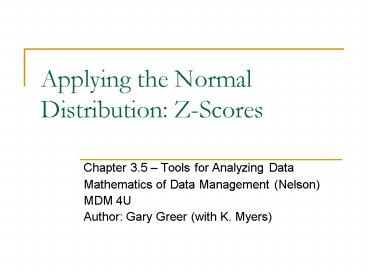Applying the Normal Distribution: ZScores PowerPoint PPT Presentation
1 / 18
Title: Applying the Normal Distribution: ZScores
1
Applying the Normal Distribution Z-Scores
- Chapter 3.5 Tools for Analyzing Data
- Mathematics of Data Management (Nelson)
- MDM 4U
- Author Gary Greer (with K. Myers)
2
Comparing Data
- Consider the following two students
- Student 1
- MDM 4U, Mr. Greer, Semester 1
- Mark 84,
- Student 2
- MDM 4U, Mr. Greer, Semester 2
- Mark 83,
- Can we fairly compare the two students when the
mark distributions are different?
3
Mark Distributions for Each Class
Semester 1
Semester 2
74
58
50
82
90
98
66
99.4
89.6
79.8
70
60.2
50.4
40.6
4
Comparing Distributions
- it is difficult to compare two distributions when
they have different characteristics - for example, the two histograms have different
means and standard deviations - z-scores allow us to make the comparison
5
The Standard Normal Distribution
- a distribution with a mean of zero and a standard
deviation of one XN(0,1²) - each element of any normal distribution can be
translated to the same place on a standard normal
distribution using the z-score of the element - the z-score is the number of standard deviations
the piece of data is below or above the mean - if the z-score is positive, the data lies above
the mean, if negative, below
6
Standardizing
- the process of reducing the normal distribution
to a standard normal distribution N(0,1) is
called standardizing - remember that a standardized normal distribution
has a mean of 0 and a standard deviation of 1
7
Example
- for the distribution XN(10,2²) determine the
number of standard deviations each value lies
above or below the mean - a. x 7
- z 7 10
- 2
- z -1.5
- 7 is 1.5 standard deviations below the mean
- 18.5 is 4.25 standard deviations above the mean
- b. x 18.5
- z 18.5 10
- 2
- z4.25
8
Example continued
99.7
95
34
34
13.5
13.5
2.35
2.35
10
12
14
8
6
16
7
18.5
9
Standard Deviation
- a recent math quiz offered the following data
- the z-scores offers a way to compare scores among
members of the class, find out how many had a
mark greater than yours, indicate position in the
class, etc. - mean 68.0
- standard deviation 10.9
10
Example 2
- compare your mark to the rest of the class
- suppose your mark was 64
- z (64 68.0)/10.9 -0.367
- (using the z-score table on page 398)
- we get 0.359 or 35.9
- so 35.9 of the class has a mark less than or
equal to yours
11
Example 3 Percentiles
- the kth percentile is the data value that is
greater than k of the population - if another student has a mark of 75, what
percentile is this student in? - z (75 -68)/10.9 0.642
- from the table on page 398 we get 0.739, so the
student is in the 74th percentile
12
Example 4 Ranges
- now find the percent of data between a mark of 60
and 80 - for 60
- z (60 68)/10.9 -0.733 gives 23.2
- for 80
- z (80 68)/10.9 1.10 gives 86.4
- 86.4 - 23.2 63.2
- so 63.2 of the class is between a mark of 60 and
80
13
Back to the two students...
- Student 1
- Student 2
- Student 2 has the lower mark, but a higher
z-score!
14
Exercises and Assignment
- read through the examples on pages 180-185
- try page 186 2-5, 7, 8, 10
15
Mathematical Indices
- Chapter 3.6 Tools for Analyzing Data
- Mathematics of Data Management (Nelson)
- MDM 4U
- Author Gary Greer (ideas from K. Myers)
16
What is an Index?
- an index is an arbitrarily defined number that
provides a measure of scale - Body Mass Index (BMI) is an example
- these are used to indicate a value, but do not
actually represent some actual measurement or
quantity so that we can make comparisons
17
Exercises
- read p189-192
- describe
- Body Mass Index
- Slugging Percentage
- Moving Averages
- try page 193 1 - 4, 8, 9
18
References
- Halls, S. (2004). Body Mass Index Calculator.
Retrieved October 12, 2004 from
http//www.halls.md/body-mass-index/av.htm - Wikipedia (2004). Online Encyclopedia. Retrieved
September 1, 2004 from http//en.wikipedia.org/wik
i/Main_Page

